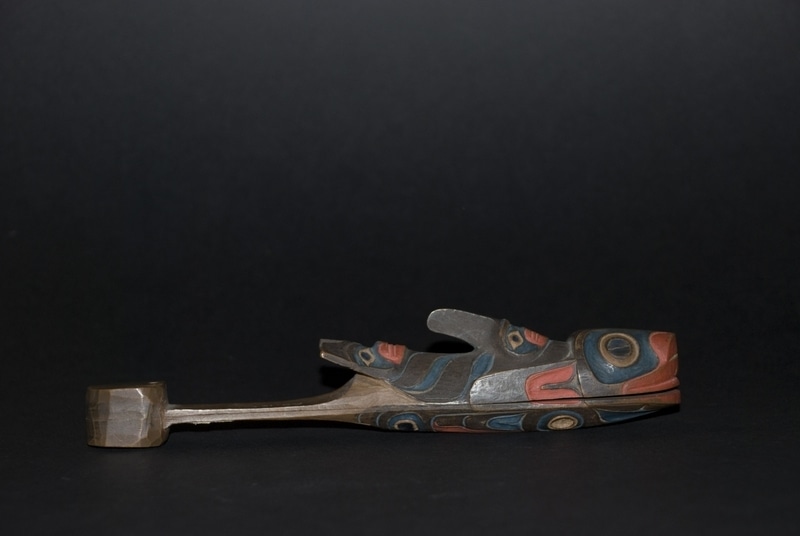Clapper Item Number: 1885.66.17 from the MAA: University of Cambridge


Description
Clappers very finely carved in the form of a killerwhale. The killerwhale is expertly executed with U- forms and deep inlaid (haliotis) ovoids. Its mouth is painted red, and there are fins close to the sides of the body, the dorsal fin has a small humanoid face where the blow hole would be positioned, suggesting transformation. The tail is also the face of a bear with the bifurcating tail being its ears. The clappers are painted red, blue-green and black. The handle narrows, making the flexible join necessary to produce sound, the two pieces are pinned with a copper nail. The killerwhale section of the clappers are hollow.; Good
Context
The provenance of Metlahkatla has been written in what must be Hepburn' s hand on the handle of the clappers. Metlahkatla was the model village founded by William Duncan, a lay preacher in 1862. At Metlahkatla Duncan encouraged the Tsimshian to give up their traditional lifestyle and convert to Christianity, he also encouraged several commercial enterprises, which included the manufacture of tourist art objects. Many tribal groups visited Metlahkatla, making it an ideal place to acquire objects. The other set of clappers 1885.66.15 have been assigned a Bella Bella provenance. The similarity of style exhibited between the two sets of clappers suggests a similar origin (G.Crowther). Clappers were used during winter ceremonials and often accompanied the dramatic presence of individuals possessed by spirits (G.Crowther).; Exhibited: Old Anthropological displays at CUMAA, case 30, dismantled 081986. New Anthropological displays at CUMAA, square case, 1990-.; Collected by: Hepburn.J.E
Item History
- Made in Metlahkatla, British Columbia, Canada
- Received from J.E. Hepburn during 1885
What
- Name
- Clapper
- Identification Number
- 1885.66.17
- Type of Item
- clapper
- Material
- wood, metal, copper metal and abalone shell
Who
- Culture
- Heiltsuk ?
- Received from
- J.E. Hepburn
Where
- Holding Institution
- MAA: University of Cambridge
- Made in
- Metlahkatla, British Columbia, Canada
When
- Acquisition Date
- during 1885
Other
- Keyword
- Masques and Drama; Music; Ceremonial Objects